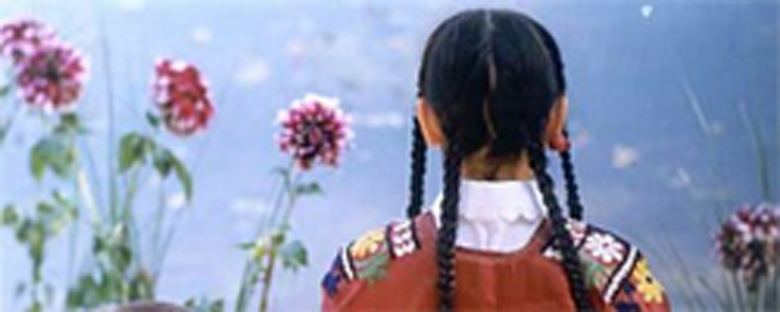Reviews
Sokout
Mohsen Makhmalbaf
Iran / Tajikistan / France, 1998
Credits
Review by Ian Johnston
Posted on 06 February 2006
Source New Yorker DVD
The figure of the child has been a recurring motif in Iranian films. One reason for this is an institutional one. Iranian state-funded film bodies finance films whose remit is to educate and raise civic consciousness among the population at large, and children are often the subject-matter and target-audience. Hence, for example, many of Abbas Kiarostami’s films of the seventies and eighties — whether fiction (e.g. Where Is The Friend’s House?) or documentary (e.g. Homework) — deal with children and/or school. In addition, the use of a child as a central protagonist can make it easier for a director, working in a state like Iran that places severe limits on freedom of expression, to address politically- or socially-sensitive issues.
But for all the estimable Iranian films that have centred on child protagonists — take as examples The Mirror (Jafar Panahi), The Apple (Samira Makhmalbaf), the first story of The Day I Became A Woman (Marzieh Meshkini), or A Time For Drunken Horses (Bahman Ghobadi) — it’s true that there’s a host of others (the likes of Children of Heaven) that simply milk the sentimental potential of putting a poor little mite on the screen. And I have to say that there’s a strong sense that this is what Mohsen Makhmalbaf is up to in The Silence.
The Silence shares the striking visual beauty of Makhmalbaf’s earlier Gabbeh, although it’s often a beauty cut adrift from narrative meaning. It also marks Makhmalbaf’s further physical estrangement from mainstream Iranian society. Gabbeh had been set among a nomadic tribe in southeastern Iran, and with The Silence the director moves outside of Iran, to Tajikistan. There’s no doubt a political dimension to this, a sign of the difficulties Makhmalbaf has in operating in the increasingly conservative cultural arena in Iran itself. (His last three films have all been set and shot in Afghanistan.)
The story is a simple, straightforward one. It centres on Khorshid, a blind ten-year-old whose job in a small instrument-making workshop is the main source of income for his mother and himself. Materially, they are threatened by loss of home and job — they’re about to be evicted unless they can come up with the rent, and Khorshid is close to losing his job as he’s continually late for work. The reason for this constant lateness is that Khorshid is distracted by the sounds of the world around him, and Makhmalbaf’s strong and vivid visual/aural depiction of Khorshid’s distractions is the main motif that runs through the film.
There’s a sense in these scenes that Khorshid is not only distracted by the sounds he hears but that he makes these sounds his own, creating his own world out of them. Makhmalbaf marks this with the repeated shots of Khorshid’s fingers plugging and unplugging his ears and with the way the sound of running water is overlaid on the sounds he hears. This appropriation of sounds is the means by which someone who is powerless and disenfranchised can make his mark on the world, and this is the meaning of the film’s climax. Here, Khorshid, although he and his mother have been evicted and he has lost his job, joyously conducts the world around him in a performance of the opening bars of Beethoven’s Fifth Symphony (another running motif of the film). It’s an affirmation and a celebration of the power of art and imagination over material circumstances.
Makhmalbaf is a very uneven director. His films are full of startling and beautiful images, but they often lack any cohering, underlying structure. The Silence itself is full of single, often mesmerising shots of rich, intense, intoxicating colour—the track along the line of brightly-dressed bread-sellers, for example; the close-up on the cherries the girl holds to her ears as earrings; the two broken shards of mirror on the grass, with Khorshid reflected in one and the girl reflected in the other; or the shot of Khorshid lying on the grass, almost completely covered in yellow leaves.
The great idea in this film is the depiction of Khorshid’s experience of the world around him. One example: an oud-player (an oud is a traditional string instrument) on his bus starts strumming his instrument; Khorshid puts his fingers in his ears and the sound of flowing water rises on the soundtrack; we then return to a shot of the musician playing his oud, but this time the only sound is of water.
Makhmalbaf’s style is to seek these kinds of poetic effects, often with an overlay of symbolic resonance. So, he intercuts a shot of a horse running through shallow water with one of Khorshid doing the same. But often he abandons any realistic connections within one sequence for the sake of a striking shot. The lovely effect of the rain plinking on the strings of the oud Khorshid carries through a downpour is then followed by a shot of Khorshid immersed in water and the oud floating nearby. The image looks great but there’s no motivation for it, no development on it, and no connection with what follows in the narrative.
Makhmalbaf’s great strengths and great weaknesses are those of the film. The Silence is an empowering, inspiring narrative; its main motif, its play with image and sound as a reflection of Khorshid’s subjectivity, is strikingly effective; it offers an array of rich, beautiful images; but in the end those images are isolated, disparate ones in a film that fails to cohere in a truly satisfying way.
We don’t do comments anymore, but you may contact us here or find us on Twitter or Facebook.



